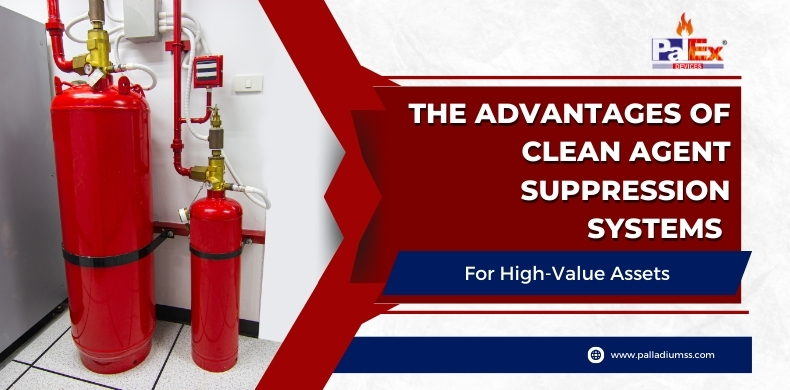In the domain of fire protection, guarding important assets is a special task. A center for data, a museum with valuable items or a factory having delicate equipment; all these places find it hard to trust in traditional ways of suppressing fire. But now we have clean agent suppression systems – an updated answer that provides better safety without the limitations encountered by typical methods. Let’s explore why these systems are becoming the go-to choice for protecting high-value assets.
Understanding Clean Agent Suppression Systems
Clean agent suppression systems utilize gaseous fire suppressants that are electrically non-conductive, volatile and do not leave any residue after evaporation. These systems are made to put out fires rapidly while causing minimal harm to the environment and safeguarded items.
Clean agents that are most often applied in these systems include hydrofluorocarbons (HFCs) such as FM-200 and HFC-227ea, plus inert gases like Inergen and Novec 1230. Every kind of clean agent has its own distinct features but they all possess the main benefits making them perfect for safeguarding high-value assets.
Rapid Fire Suppression
A key benefit of clean agent systems is their quickness. Once they identify a fire, these systems can release the suppressing agent in just seconds, usually putting out the flame when it’s still very small. This fast action is important for places where even a small fire could lead to big harm or loss of information.
Clean agents, compared to water-based systems, have a quicker reaction time for suppressing fires. They rapidly fill the protected area with the agent that suppresses fire and lower oxygen levels or stop the chemical reaction of fire almost instantaneously. This ability extinguishes flames efficiently before they spread.
Also read : What are the 3 Most Common Fire Extinguishers?
Minimal Collateral Damage
Clean agent systems possess a key advantage in their capability to extinguish fires while minimizing harm to the safeguarded items. They do not leave behind any residue or conduct electricity, meaning they are perfect for environments containing delicate electronic gear, invaluable papers, or priceless works of art – unlike water-based systems that can cause severe damage when used.
Picture a situation in a data center. A water sprinkler system could put out a fire, but the servers and electronic equipment might endure significant damage from water. In contrast, a clean agent system could stop the fire without causing harm to the equipment, potentially saving millions in hardware costs while also protecting against severe data loss.
Safe for Occupied Spaces
Most clean agents are safe for use in occupied areas. They are non-toxic and when applied at correct levels, they don’t create substantial health dangers for humans. This implies that if there is a discharge, the staff can leave without concern about being exposed to dangerous chemicals.
This safety factor is especially crucial in situations where quick evacuation could be difficult or when humans are always present, like control rooms and some manufacturing settings.
Environmentally Friendly
Modern clean agents are made to be environmentally friendly. They usually have zero ozone depletion potential and small global warming potential. This makes them more sustainable than the older halon-based systems, which were stopped because of their bad effect on environment.
Clean agents are also known for being environmentally friendly. They follow present and expected regulations, making these systems a wise choice for businesses that want to remain compliant with new rules over time.
Also read : 10 Causes of House Fire
Space-Efficient Design
Clean agent systems usually take up less area because the agents are saved in cylinders that need very minimal floor space. This can be a big benefit in environments where every inch counts, like crowded server rooms or compact control centers.
Moreover, the ability of clean agents to enter enclosed areas and target concealed fire sources that water or foam might not reach is another advantage. This characteristic makes them very useful for safeguarding assets with complicated shapes or closed off parts.
Challenges and Considerations
Clean agent systems also have their own difficulties. You need to keep the protected space properly sealed so that agent concentration is maintained as expected. Maintenance and regular testing are very important for checking system’s effectiveness. Also, even if clean agents in current times are good for the environment, they still have certain effects on it and need correct handling and removal.
Conclusion
Clean agent suppression systems are suitable for businesses and organizations that have the duty to safeguard high-value assets. They provide a quick reaction, low damage potential, safety for the people inside and good impact on environment which make them an outstanding option in many uses.
For the reason that technology is getting better and businesses are depending more on delicate equipment and data, it becomes very important to have good fire suppression. Clean agent systems offer a modern, useful and dependable way of keeping these important things safe.
Every fire protection case is special and needs deep thought, but the good sides of clean agent suppression systems put them at the front for any group that wants to protect their most important assets. If a business invests in these modern systems, it can be ready for fire dangers while reducing possible losses and time off work.



